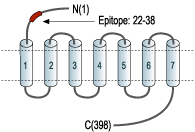Overview
- Peptide CSPAPGSWLNLSHVDGN, corresponding to amino acid residues 22-38 of the rat µ-Opioid receptor (Accession P33535). Extracellular, N-terminus.

- Pan, L. et al. (2005) Neuroscience 133, 209.
- http://www.guidetopharmacology.org/.
- Matthes, H.W. et al. (1998) J. Neurosci. 18, 7285.
- Shaqura, M.A. et al. (2004) J. Pharmacol. Exp. Ther. 308, 712.
- Baraldi, P.G. et al. (2006) Curr. Med. Chem. 13, 3467.
Endogenous opiates such as endorphins, endomorphins, and enkephalins, as well as opiate drugs (including morphine) exert their effects by binding to opioid receptors. Three "classic" types of opioid receptors have been identified: mu (µ)-opioid (MOP) receptor, delta (δ)-opioid (DOP) receptor, and kappa (κ)-opioid (KOP) receptor1. Recently, the nociceptin/orphanin FQ (N/OFQ) peptide (NOP) receptor was also described. Despite its significant sequence homology, its pharmacological profile differs greatly from those of the classic µ, δ, and κ receptors2.
The opioid receptors belong to the G protein-coupled receptor (GPCR) superfamily whose members share a common structure of seven putative transmembrane domains, an extracellular amino terminus, a cytoplasmic carboxyl terminus, and a third intracellular loop important for binding G proteins1.
All three receptors mediate opioid-induced analgesia. Supraspinal analgesia is mainly mediated by the µ-receptors, whereas µ-, δ-, and κ-receptors participate in the control of pain at the spinal level. These receptors also mediate the mood-altering properties of opioids3.
Of the opioid receptors, the µ-opioid receptor has been the most extensively studied due to its important role in mediating the actions of morphine and other analgesic agents, as well as other addictive drugs such as heroin1. The µ-opioid receptors are expressed in the central nervous system (CNS) and in the peripherial nervous system4. The highest densities are found in the thalamus, caudate putamen, neocortex, amygdala, and other brain regions known to have well established roles in pain and analgesia5.
Application key:
Species reactivity key:
Anti-µ-Opioid Receptor/OPRM1 (extracellular) Antibody (#AOR-011) is a highly specific antibody directed against an epitope of the rat protein. The antibody can be used in western blot, immunohistochemistry, live cell imaging, and indirect live cell flow cytometry applications. It has been designed to recognize MOR-1 from rat, human, and mouse samples.
Anti-µ-Opioid Receptor/OPRM1 (extracellular)-FITC Antibody (#AOR-011-F) is directly conjugated to fluorescein isothiocyanate (FITC). The antibody can be used in immunofluorescent applications such as direct live cell flow cytometry.

